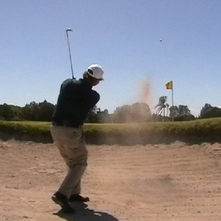 If you’ve been reading our blog entries for a while you’d know that David and I regard the process of practicing golf correctly very important. Quite frankly it’s amazing to us that there are so many amateur and professional golfers who desperately want to lower their score average and don’t really know how to go about it. As you know, you define any golfer’s level of competency by their score average, and not by the way they hit their shots, because golf is a game of score first and foremost and that’s the name of the game. Typically the golf improvement strategy that many golfers adopt is to watch how other golfers practice and copy their methods to learn how to practice correctly, which is a recipe for disaster. 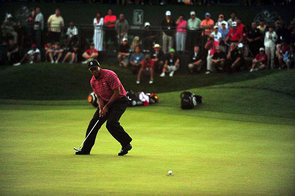 Every golfer practices for different reasons and copying another golfers approach doesn’t guarantee that you will improve your golf scores. "If you want to lower your score average the first thing you need to look at is what your score average is right now." This we have discovered is difficult for many golfers because they don’t fully appreciate the importance of this statistic. Most golfers have very little idea of what their score average is from month to month which makes it difficult to develop the appropriate skills and strategies to move you towards a lower golf score average. "There are many statistics you can study but none more important than your score average. If you discovered that you had a score average in competition of say 77.0 strokes and you decided that you wanted to lower that average to 73.0 what would you do?" What’s interesting to us is that golfers will practice their different routines on a regular basis without ever considering how they should work at their game to lower their score average. How do you practice so that the effort you invest in your game translates into lower golf scores?  In every golfers game there are three or possibly four golf skills that would guarantee improved scores by developing and improving them. The eighty-twenty principle helps us to understand that 20 percent of our golf skills accounts for eighty percent of the results we produce in every round; so it’s important that you identify these critical to performance improvement skills if you want to practice your golf skills so that you move towards lower golf scores faster. As your golf score can be broken down into short-game skills and long-game skills you need to break these skills down into sub-sets to analyse your performances and discover your critical success factors. If for example you have a score of 77.0 or five over on a par 72 golf course and your total putting for the round consisted of 31 putts you will quickly realise that putting by itself was worth 40.27 percent of your total score in that round, which is a big chunk of your golf score  Reducing your total putting average from 31 putts to 28 is almost four percent improvement, not to mention 3 strokes improvement in your score. This is one of your critical success factors. The fact is that you can and probably do spend too much of your time perfecting your full-swing mechanics in the hope that you can hit more fairways and greens in regulation and for the most part this is a sensible approach for golfers who are not hitting at least fifty percent of their fairways and greens in regulation.  If however you are hitting more than fifty percent of fairways and greens in regulation on average and your score average is higher than 76 then you definitely need to spend more time on your green-side wedge skills and approach wedge skills. You will discover that your critical success factors are mostly in the short-game area and by spending more time here you will find ways to lower your golf scores. The critical to improvement pathway in your game can only be discovered by carefully analysing your results after each round of golf you play. Whatever you score average is right now; you should know that you can lower it by focusing on developing the critical to performance golf skills that quite often are ignored in favour of the easier ones to practice. The driving ranges are full of golfers working on the wrong golf skills. Start today and keep some statistics on your rounds of golf and then break your score down to find the keys to unlock lower golf scores. Then go to work on improving the critical skills by taking a series of lessons from a competent and experienced golf instructor, practice your golf skills thoughtfully until you can see and experience improvement in your golf scores. It won't take you as long as you think. Lawrie Montague 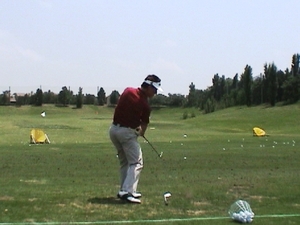 How would you like to practice so that there was a very high chance that you would significantly improve? It has been my experience that the majority of golfers practicing at their game do not know how to practice effectively. In this article I’m going to explain how to practice your golf skills for improvement. I’ll explain the key factors that influence behavioural change and the common mistakes that golfers make when practicing their golf. I’ll also describe golf ‘best practice’ techniques that you can adopt and implement into your game to improve any aspect of your performance.  "So what is golf practice? Golf practice is the procedure you use for learning, developing and acquiring golf experience." We engage golf practice routines to develop, improve and master our golf skills and we do this by repeating a highly specific behaviour many times until we have a very high degree of competency and trust in it. We do this to be able to perform a particular golf skill when it matters to us; for example hitting a high, soft pitch shot from a tight lie over a bunker to a tightly tucked pin position would require a very specific golf stroke technique that travels on a very shallow and slightly outside to inside swing path to slice the ball from its lie. Golf practice therefore is simply the reinforcement of particular actions that help to create a specific type of result or set of results that we desire and by improving the nature of the way that you go about practicing your skills, you can in turn generate the results you seek sooner. Regrettably when we practice golf skills incorrectly we are setting ourselves up for failure. In other words when we really need to produce a result, this will be the time that the particular shot you’re attempting to play will more than likely not come off as planned. An example of practicing incorrectly would be to practice golf skills that you are already very competent at. Many golfers will go to the practice range with the same golf clubs and practice with them rather than practicing with clubs that they find more difficult to use and also golf shots they find difficult to play. 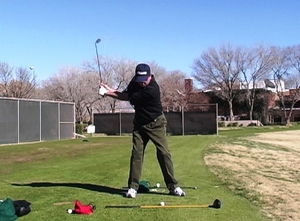 Golf ‘best practice’ can be defined as the most efficient practice method that you can use that requires the least amount of effort and is the most effective way to achieve exceptional results when performing the skill-set, based on repeatable well defined procedures that have proven themselves over time by large numbers of golfers. Practice Performance Platform So before you begin your practice session start by deciding on the best approach for improving your golf skills. The best way to go about this is to initiate a testing and measuring protocol to accurately assess the relative performance of your golf skills currently. Track and Measure If you were lost somewhere you would logically look for some point of reference to help you to determine where you are relative to where you want to be. Tracking and measuring your golf skills helps you to gain the necessary clarity you need to help you to know where your skills are at the present moment so you can determine where you wish to go with them. There is a relatively easy way to do this. Track a minimum of six rounds of golf and measure results in at least the following six categories. 1) What is your score average against par 2) How many tee-shots you hit into the fairway 3) How many greens you hit with your approach shot in regulation (e.g. Hit a par 4 in two shots or a par 3 in one shot) 4) How many putts you had for 18 holes 5) How many bunker shots you hit onto the green and made one putt 6) How many chip and pitch shots you hit onto the green and made one putt Now of course you can measure many more categories with much greater detail if you like, and this will be dependent primarily on your golf skill ability. Low handicapped amateurs and professionals will measure many more categories with much greater detail to extract the information they need to develop a suitable plan for improvement. If you are a high handicapped amateur then the abovementioned categories are a good beginning. Forecast and Estimate Forecasting the amount of improvement you desire is essential for developing a planned approach to your golf improvement as well as fuelling your focus and desire to improve. Every successful golfer is motivated by performance goals and forecasting your future performances just helps you to stay on track with your improvement as well and also helps you to determine how you should get there. Once you’ve tracked and measured the different skills that make-up a round of golf you need to estimate the amount of improvement you desire sometime in the future. If after six rounds you discovered that you hit thirty eight percent of fairways and that seventy percent of those tee-shots missed to the right, and you forecast that within six months you will hit at least forty eight percent of fairways or ten percent improvement in your tee-shot accuracy, your next step would be to decide what you need to do next. 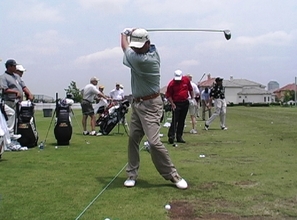 Isolate and Prescribe Ok here’s where the rubber meets the road. Now you need to isolate the critical element in your technique that would help you to achieve better results. Of the categories you tested and measured, and using the driving accuracy example from earlier, what specifically will you do to improve your driving accuracy? Remember you’re looking for ten percent improvement over six months which equates to around one and half percent improvement per month. So you need to find a method for making the golf ball travel more down the target line so you can hit more fairways. You’ve isolated the problem that your tee-shots are travelling too often to the right of the fairway and now you need to prescribe a specific drill or training technique that will alter that situation and move you towards your ten percent improvement goal. This is where a series of lessons with a competent and experienced golf teaching professional would make good sense as you can isolate the problem in your golf swing technique faster so you can get on with the job of improving your tee-shot accuracy.  Manage and Monitor The final step in the process is to determine how much work (effort) you will put into your golf practice to improve your performance by around 1.5 percent each month. You will need to manage your effort and also monitor your progress continually to ensure that you remain on track with your improvement. Managing your effort means to develop practice routines that incorporate the specific skills that you need to learn, modify or improve. When you practice your skills you will have to involve the following four practice dynamics in each practice session to influence how much improvement you will make each month. Volume: This is the exact amount of golf balls you will hit during each golf training session. Ideally you will break your practice volume into manageable sets of golf balls and hitting sets of ten or twenty golf shots per set makes it easy for you to stay focused, and it’s also easy to measure and manage. Frequency: This is the rate of recurrence of practicing a particular skill. How often do you need to practice certain skills, and when is the best time to perform the skill? Should you practice putting after hitting three sets of driver shots – probably not? Managing the frequency of your practice helps you to manage energy expenditure and focus and is critical when developing an effective practice plan. Duration: This is the period of time you actually invest in hitting your golf shots. The time it takes to hit sets of golf shots will vary depending on whether you’re practicing using a pre-shot routine or not. Technique practice doesn’t usually require that you use a pre-shot routine where practicing targeting skills does. So practice duration helps you to manage the different skills you will practice and fit them into your total plan. If you know that it takes you four minutes and thirty seconds to hit ten pitch shots to a target then you can easily work out how long it will take to hit ten sets of ten pitch shots to a target which will help you to plan your practice program more carefully and effectively. Intensity: This is the level of focus or concentration you involve in your practice in practicing each skill. When you break your practice volume down into sets of ten golf shots and you practice the right skills at the best time, and you have worked out how many sets of shots you need to hit you will find it easier to focus on your skills and get the most out of yourself. Focus varies depending on the importance of the practice routine however by practicing correctly you give yourself the best opportunity to practice efficiently and effectively. When you practice a skill set the key is to control what you’re paying attention to. Your responsibility is to control your eye gaze and maintain it for each and every shot.  Practicing your golf skills correctly means building a platform of strategies that support and enhance your effort to improve. It’s easy to just go out to the range and hit golf balls and hope that you will do something that makes you improve. It’s much more beneficial to perform your practice skills correctly by planning your development strategy carefully and implementing it into your program so that the effort you put in actually leads to outcomes that you expect. Remember to always begin with the end in mind. Decide what you want to achieve from your golf game and notice where you are with it right now. Then go to work building a bridge from where you are to where you wish to go. Take your time, really think it through, and in the days, weeks and months ahead you’ll discover how to get to the other side of golf improvement. Lawrie Montague 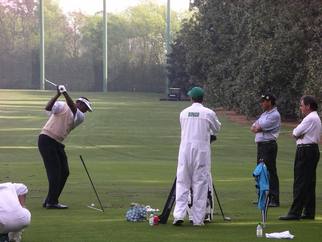 The most effective practice drills golf tour player’s and leading amateur golfers use are the drills that are designed specifically to help them to make the transition from the practice tee to the golf course as easily and quickly as possible. In this golf instruction article I’ll explain how performing a golf practice drill correctly will significantly improve your chances of taking it to the golf course without the usual prolonged distress usually associated with golf swing changes using what I call the “5 D Success Formula.” The less complicated a change to your golf swing is, the faster you can adapt to the changes on the golf course. The biggest challenge facing any golfer is the fear that the change to your golf technique will leave you in a kind of “golf swing limbo” where you can’t go back to your old golf swing, and you haven’t got enough trust in your new golf swing. So the more elements of a golf swing you have to focus on to improve your technique the more destructive it is to your golf confidence. Quite simply, if you’re thinking about more than one swing thought as you swing the golf club you will more-than-likely fail to execute your golf shots with a high degree of precision and consistency. A helpful way to understand this is to recognize two important factors in changing your golf swing with golf practice drills. One is the actual drill itself and the second is its level of complexity. When you focus on performing one simple training drill like cocking your wrists before you swing your arms back is a relatively easy exercise to accomplish.  However when you attempt to combine two practice routines at the same time, the complexity level jumps up significantly. Basically the complexity of the drill sky rockets for every additional component you add to your training drill. The simplest example I can share with you is the golfer who performs a particular technical drill on the driving range and at the same time attempts to hit his golf shot accurately to a target. "Basically the complexity of the drill sky rockets for every additional component you add to your training drill. The simplest example I can share with you is the golfer who performs a particular technical drill on the driving range and at the same time attempts to hit his golf shot accurately to a target." It might seem harmful-even easy to do and yet it is arguably the single biggest reason why amateur golfers struggle to make the transition from driving range to golf course. The whole idea behind performing golf practice drills is to facilitate a change in your golf technique faster and more effectively than just hitting golf shots and attempting to change your technique through repetition alone. Golf practice drills help you to change a portion of your technique and integrate the change smoothly into your overall technique. The key is to reduce complexity, increase competency which ultimately leads to increased golf confidence on the golf course. So how do tour pro’s practice their drills? "Very carefully, and by concentrating on one piece of the puzzle at a time..." Tour pro’s have discovered through countless hours of practice on the driving range that attempting to focus on performing a drill and trying to hit a perfect shot at the same time is the equivalent of speaking on your mobile phone whilst driving in traffic. It’s difficult to do, dangerous, and the outcome is not likely to be helpful in the long run. The best type of practice drill is the one that helps you to hit your golf shot straighter and more solidly time and time again. This seems logical enough and yet it’s surprising how many golfers practice drills that are not compatible with their particular problem. For instance a golfer might be practicing a split hands drill where you hold each end of the grip with a gap in the middle to help facilitate the rotation of the club-face through the impact zone to straighten a persistent slice shot. The problem in this example is that often this drill is used to try and fix an over-the-top downswing, whereas this type of drill is actually designed for the bottom of the swing, as opposed to the top of the swing which is where an over-the-top down swing problem originates. You can waste a lot of hours toiling away at golf practice drills that are incompatible with your particular swing needs.  Here is the “Five D Success Formula” which is a practice drill framework you can follow that will make certain that you’re on the right track as you go through the golf swing change process.
By following this practice drill framework you will keep your focus on habituating the most relevant part of your golf swing technique. You will need to repeat the practice drill you've chosen at least one thousand five hundred times before you start to reach the stage of development called “unconscious competence.” This is high trust stage of golf swing performance where you can hit golf shots without thinking about how you hit golf shots. Don’t be put off by the amount of repetition required; you cannot achieve this superior level of performance without at least this amount of repetition so just give yourself the time to do the drill work. Twenty five correctly performed drills per day for sixty days in front of a mirror at home and you’ll have incorporated a new part into your golf swing technique. If you want to achieve it faster than that you can perform fifty repetitions three times per day for ten days and you’ll create the same effect. Either way, you should memorize this simple mantra; “repeat regularly to re-train and retain.” The positive side of performing your golf practice drills regularly is that they will lead you directly towards a great deal more golf confidence and ultimately much improved performances on the golf course which will translate into lower golf scores and far more enjoyment. Lawrie Montague  Is there anything worse than playing one bad hole that ruins what was potentially one of the best rounds of your golfing life? For many golfers there is nothing worse. It’s hard to be philosophical when you have just had a double bogey on the last hole! You could simply put it down to experience and acknowledge that if you get yourself into a position to produce an excellent round again, you would do it differently. So how do you rebound back from a bad hole or holes that keeps your score average higher than it should be? I get asked this question a lot of times and the first thing I explain to students is that they need to understand that just because you have a bad hole doesn’t mean that there is something wrong with you, or your game. "You are not your bad golf score!" Golf is a game built upon mistakes, not good golf shot’s. It’s a highly technical game that for the most part can’t be mastered consistently by anyone; not even Tiger Woods.  Look at the scores of PGA tour golfers and LPGA golfers and you’ll see that their golf scores ebb and flow from hole to hole and round to round. Of all the statistics on the PGA tour the one the touring professional’s value almost as highly as the low score average is the “bounce back” statistic. "The bounce back statistic measures the percentage of holes on which a golfer is over par on one hole and under par on the next. It’s another way of expressing the player’s ability to forget the past hole and get on with the next shot." It is totally unrealistic to think that any golfer can achieve a high degree of consistency when the golfing environment you play in changes constantly. In fact we can say that the only thing that is consistent about golf is that it is inconsistent. It changes constantly and so should you. My suggestion is that you learn to develop a more flexible mind-set. If you’re someone who has at least one bad hole during a round, then ask yourself whether your mind-set tends to be consistent and inflexible. My experience working with many golfers over the past twenty years suggests that many golfers have rigid and unbending thinking strategies and as a consequence play their golf course with the same expectations and game plan over and over. 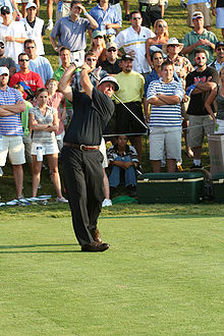 I'm sure that you appreciate that you have many ways that you can play a hole and produce your score. So if you tend to play a certain hole with less than ideal results from week to week, then you should consider an entirely different approach to playing that hole. Bad holes usually result from a defensive attitude to playing the hole. The simple way to overcome this defensive attitude is to play a golf club from the tee that you know you can play confidently at least seventy percent of the time. It doesn’t make sense hitting your driver off the tee if you can only hit it in the fairway a low percentage of times. This will place excessive pressure on you and you will not make a positive, free-flowing golf swing. If instead, you hit a five wood from the tee because your percentage of success is much higher; your positive attitude will definitely help you to produce a better score on the hole. The next time you go out for a round of golf make a contract with yourself that you will play your entire round using golf clubs that you wouldn’t normally use. Get used to the idea of adapting to changing conditions and develop an attitude of acceptance when you have a higher score than you expected on a hole. By learning to let go of the frustration, bitterness or anger quickly you will be able to re-focus your mental energy on playing the next hole with a fresh perspective.  Improvise, Adapt and Overcome The US Marines have an amazing capacity for creative thinking. The unofficial mantra of the United States Marine Corps is Improvise, Adapt and Overcome which is based on the fact that the Corps generally received Army hand-me-downs and the troops were poorly equipped. The Marine’s utter drive and dedication towards accomplishing the mission, even when faced with what appeared to be impossible odds is legendary. Read more: http://socyberty.com/advice/life-lessons-from-the-marines-improvise-adapt-overcome/#ixzz1H8NpUGUv The Marine Corps has been successful mostly because of the creativity of its people and their success-based attitude. You will discover a rare and exciting freedom in developing a success based attitude by letting go of your old and tired approach to the game in favour of a more flexible and positive approach through adapting to new ideas and overcoming your limiting beliefs.
Develop a positive bounce back attitude and it will help you to shoot lower golf scores and become a far more competitive golfer. Lawrie Montague  The only true measure that really counts for a tour golfer is their competitive score average. PGA money winners know that to move higher up the money list you need to shoot lower golf scores consistently. When did we lose sight of the fact that this is what the game of golf is all about? Golf has always been a game of score and not a game of swing.  When you go into the golf history books from the nineteenth century you will read fascinating accounts of classic battles on the golf course between the golfers from different parts of Scotland. These golf battles were battles of score. This is the essence of golf, and the best golfers have always known that to get to the heights of the game you must master the scoring aspect of golf. This is also what the spirit of golf is all about. Golf is a game of score, and to play the game really well you have to learn how to adapt to all types of weather and course conditions and skilfully execute all types of golf shots.  "The only true measure that really counts for a tour golfer is their competitive score average. PGA money winners know that to move higher up the money list you need to shoot lower golf scores consistently" When I was a young man all I wanted to do was play golf on tour. PGA golf professionals in Australia train for three years as an apprentice under the guidance of a senior professional golfer. I trained at one of the best golf courses in Australia and my boss, a former tour player and fine golfer taught me many important things about how to play golf on tour. Of all the things I learned from him in my quest to play on one of the pro golf tours the most important lesson, which was really a question has significantly affected my thinking and continues to do so because it’s simple, straight to the point and highly relevant. “What score did you shoot today?”… Not “how did I swing the club today?”, or, “how many birdies did I make?” or "who did you play golf with today?" just simply “what golf score did you shoot today?” If I proceeded to go into a song and dance about all that could have been on the golf course he would cut me off, raise his voice a little and ask me exactly the same question again, followed by silence. "I quickly realised that to him all that really mattered was what golf score did I produce? I learned a very important distinction about golf, that above all else golf is a scoring game and not a golf swing game." To me this way of thinking was a paradigm shift of epic proportions, because as a kid growing up I couldn’t wait for the next issue of golf magazine or golf digest to read about the views of expert analysts dissecting the golf swings of great golfers.  However in learning to become a pro tour golfer my mentor was telling me to get my focus in the right place. "Focus on developing your golf scoring skills!" As a full time golf instructor for more than twenty years I have witnessed countless male and female golfers spending most of their available time perfecting their golf swing mechanics rather than developing their golf scoring skills. Many pro tour golf instructors are employed by leading pro tour golfers mostly to keep their golf swing in check or to improve them, and the golf media sells the story of the golf swing transformation enthusiastically to a large and thirsty audience every month.
Golf magazine publishers know that this is the ‘hot button’ for most golfers and you quickly have this confirmed when you have a look around the golf forums on the internet. But if you really want to lower your golf scores and your golf handicap then you should take a really good look at how much time you currently spend on the scoring skills of your game. Why don’t you make it a goal this year to spend eighty percent (you read correctly) of your time working on your chipping, pitching, putting and sand shots and twenty percent on improving your golf swing technique? Imagine what this will do for your golf score and when you are asked the question; "what score did you shoot today?" you can confidently respond by saying... Lawrie Montague P.S Don't forget that our 1st semester for Pro Tour Golf College 2011 is just around the corner and if you're really serious about lowering your competitive score average in 2011 then make contact with us today. You won't regret it.  I was recently asked by one of the leading golf magazines what I would do with Tiger Woods swing if I coached him. Like any golf student that comes to me the first thing I would look at is where the strengths and weaknesses are in his game by looking at his statistics comparing them when he's scoring well and when he's not. The reason is that it’s not how good looking his swing is but how low he is scoring currently. "Low scores are the bottom line, that's what wins golf tournaments." So let’s start by comparing Tiger's key stats in the 2011 season against his stats when arguably he was playing and scoring his best in the 2000 season. 2011 SEASON 2000 SEASON Driving Accuracy 45.54 percent Rank 191st Driving Accuracy 71.22 percent Rank 54th G.I.R 69.44 percent Rank 30th G.I.R. 75.15 percent Rank 1st Scrambling 57.50 percent Rank 110th Scrambling 69.67 percent Rank 3rd  It is quite evident that Tiger has to improve his driving and scrambling stats to get back to being the dominant player he was. His G.I.R which is mainly iron approaches has deteriorated but is still competitive. This indicates to me that the swing he currently has is more suited to iron shots where a more descending approach is required compared to the driver where striking the ball at the base of your swing or even a slight ascending strike is required to get the best results. "Tigers angle of approach of the club head with his driver is way too steep and makes it impossible to match up a square club face at impact consistently. I’m sure you have seen him take divots with his 3 & 5 woods even when he tees it up."  It is my observation and belief that Tiger’s lower body motion is the main culprit of his steep angle of approach with his driver. It has been well documented and shown in slow motion Tiger’s drop in height as he initiates the downswing and this in itself is not the cause but coupled with his right heel lifting straight up which in turn raises his right hip and takes the space where his arms need to swing. This results in the famous “Trapped” feeling Tiger has on numerous occasions described as why he blocks and hooks his drives. From this “Trapped” position his solution is to snap his left leg straight as fast as possible to clear his left side and after the surgery on the left knee it is not as stable as it used to be causing the left foot to slide. The left foot sliding at impact is not good as achieving solid ground force with the lead foot is essential to being able to deliver the required compression to the ball. Squarer the impact the more compression is applied to the ball. 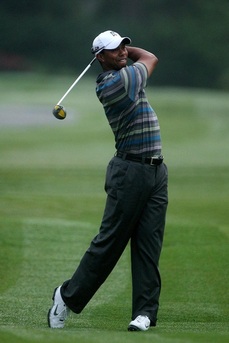 So what adjustment is required for Tiger? I would get him to roll his right ankle inwards keeping his right heel on the ground longer ( he does this with his irons beautifully) as he starts his downswing and “post up” with his left leg. This will allow him to initiate his downswing swing from the ground up and still create the stability and space for his upper body and arms to deliver the club head on a more shallow angle of approach to the ball and not have to try and fix the clubface at the last moment. At the present time Tiger is working on matching up the release point for all his shots, driver to putter but I believe if he fixes his lower body motion the release is automatically improved. The release should be an effect. I am not sure what his driver specifications are but he was the leader in all round driving (combines length and accuracy) when he was using a 43” steel shafted driver back in 2000. 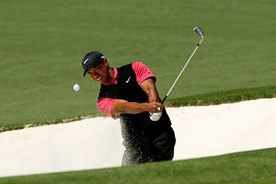 On the scrambling stats Tiger has been the loser of the new groove rule. He could control the old grooves and high spin better than anybody else on tour but now he hasn’t got the “square” grooves to get him out of trouble like he used to. It was like Greg Norman ability to drive it longer and straighter than anybody else with the Persimmon driver and high spin balata balls and this advantage was cancelled when metal drivers and low spin balls became available in the 90’s. In conclusion I would get Tiger to improve his driver swing by fixing and improving his lower body action which will allow him to deliver the club head on a shallower angle of approach and strike the ball more on the up-stroke. The path therefore for his driver will be more from slightly inside to square and his irons as he delivers the club on a more descending approach to the ball will be more down the line and to the left of target.
Good Golfing David Milne P.S Our first intake for Pro Tour Golf College 2011 is April 18th, so if you're really serious about playing on tour or becoming a lot more competitive golfer who shoots lower golf scores then contact our admissions team now at [email protected] or fill in our contact form under the 'contact tab' above. 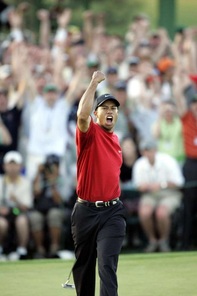 How do Tiger Woods and other PGA tour players perform so well when the spotlight is on them? They seem to confidently manage fear and distraction so much easier than the rest of us, so what is their secret to golf confidence? There’s no doubt that if you could better manage or even eliminate some of these distractions, your golf would be much better and you’d be having a lot more fun right? When you think about it there are three possible solutions; one is giving up golf and taking up another sport (an aweful idea), the second is to keep doing what you’re doing (another aweful idea), and the third one is to learn some simple effective mental strategies to eliminate the problem. Have you noticed that the things that you do easily and well require very little thought and effort? Why should hitting a putt that is only three feet from the cup be such a problem? The length of the stroke is literally only inches long and yet for many golfers it’s more difficult to perform than hitting a drive from the tee box. The things that create mental angst are more than likely associated with the fear of producing an undesirable result or embarrassing yourself. Now even though fear is just a word, like the word choking, for many golfers it represents itself in your mind as a very definite problem. For some it’s represented as negative self-talk, for others it’s represented as negative feelings, and for still others it’s negative images or a combination.  The secret is to change how you represent the problem to yourself. For instance you can listen to the negative chatter that’s going on inside your head, or you can change the volume. Turn it down until you can no longer hear it anymore, or change the tone to an upbeat happy tempo like circus music. "You will notice that when you change the structure of your experience you change how you represent it to yourself." If the problem is represented as a negative feeling in your body, how would you describe the feeling? If it’s strong in intensity, reduce the intensity by moving it away from you. If the problem is represented visually, how do you see it? Is it dark, gloomy, black and white, and small or is it large, bright and overwhelming? Alter its structure to change how you experience it.  Use your internal confidence controls, which are just like the controls you use on your television to improve the quality of the picture. When you change the structure of your problem you can change its meaning to you. When you do this you will discover that you can easily overcome even the most challenging mental problem and dramatically improve your golf confidence. Lawrie Montague  Over the years Ernie Els has been a great chipper. This skill has allowed him to score low when his long game is on song and when its off still gives him opportunities to shoot under par. PTGC co director Lawrie Montague and I both share the same philosophy that "if you don't have a short game, you don't have any game" to shoot low scores! Now you also can be a great chipper by observing how Ernie is able to chip it close shot after shot using a simple repeating action.  Pic 1. Shows him in set up with his weight favoring his left side knees flexed and providing a stable base throughout the swing. Notice the position of his hands opposite the left thigh which creates a slight angle in the back of his right wrist. This angle is critical to you being able to impact the ball with a slight leaning shaft ensuring the ball is contacted first and then the ground.  Pic 2. All Ernie has done is maintained his address posture and made a pivot or turn with his chest away from the ball. Can't be any more simple.  Pic 3. If there is a position you want to emulate its this one. The angle in the back of his wrist is still the same as at address and backswing and all he has done is turned his chest back and transported the arms and club back to impact . Notice the clubhead has made a divot and the ball has popped up with no scoop or help from the hands. He has kept his weight in the same position up to this point  Pic 4. Ernie has continued turning his chest to the finish keeping his arms and club infront of him with the angle in the right wrist still the same as it was at throughout the swing. Observe the relaxed posture and the lack of tension in the arms. This chip will have very little spin so is very predictable and easy to repeat. The ball will land check slightly on the second bounce and release the same way every time. Control the speed and length of swing with the chest turn back and through. Take this technique to your next training session and start to "own it" and you are bound to chip it close and see your scambling statistics improve.
Good Golfing David Milne 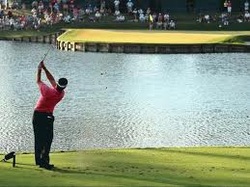 Imagine standing on the tee at the 132 yard 17th hole at TPC Sawgrass just about to walk into your shot to play it, what would go through your mind? You wouldn't be human if you didn't feel a little challenged as you contemplated playing this shot across the water to an island green. It's one of those situations where regardless of your playing ability you have to commit totally to the shot as you're not offered any other 'bail out' option. Here's a good question for you to consider; "how would you swing the golf club if you didn't have the fear of hitting poor golf shots?" Would you play better and more consistently if you could just walk up to the ball and swing the golf club with a care-free attitude? I bet you would. I'm sure you'd agree that your level of competence is greatly determined by how much belief you have in your ability to just hit your shot and not worry about the consequences. Think about it; how much time do you spend thinking about what you don't want from your game compared to what you do want?  The 17th at Sawgrass is a great example of a golf hole where you have to completely commit to the process of just hitting your shot. No frills, no fanfare, just hit the golf shot the correct distance. This is a great way to think about every golf shot you make. Just hit your golf shot and couple it with the belief that it will be successful.  The Power of Positive Commitment When a PGA tour professional plays a shot to the 17th during the Tournament Players Championship he knows that there are consequences if the shot he hits doesn't come off, but he plays the shot with the confidence that the shot will come off just the way he wants it to. This is the power of positive commitment. He knows he can hit the ball 132 yards and it doesn't really matter whether it's uphill, downhill, across the water or anywhere else, he justs plays the shot 132 yards. When an average golfer stands on the tee at 17 telling himself that he can play the shot across the water and onto the green but knows that its more likely that the ball will end up in the water then this is the opposite of positive commitment, this is a negative commitment. The golfer is positive that the experience will be negative. You see its not enough to tell yourself that you can hit your golf shot onto the green, you have to really know that you can. So many of the golfers who hit the ball into the water on 17 know that they can hit a golf shot with a short iron 132 yards (120 meters). The only thing that has changed is that they are asked to commit completely to the golf shot. This is where the problems begins for many because it now gets down to how much you trust your ability to pull off the shot. "He who lacks trust, also lacks commitment." The next time you face a golf shot and you start telling yourself that you can't do it, stop yourself, take a couple of deep breaths and focus your mental energy on imagining your golf shot behaving exactly the way you want it to. Your muscles that swing the golf club don't understand your words, they only understand your images which is where your commitment lives.
Knowing you can do something is communicated to your muscles positively so that they can respond and commit perfectly to the message. Telling yourself that you can hit the golf shot will not help you unless you can translate the words into a positive image. Positive talking with a positive commitment is the difference that will make the difference when you hit a shot 132 yards across the water to an island green. If you're not sure whether you think in images, then let me ask you this simple question "what color is your car?"....if you said its red, black, blue etc..."How did you know it was?" Lawrie Montague  Some people believe that PGA tour golfers and successful amateur golfers are talented and born great golfers. I do not. When you watch golf telecasts you will often hear the commentators mention that “such and such a player is a talented player” or that they possess “raw talent” and so on. I have always been interested in why it is so easy for people to describe anyone who is exceptional at something to describe them as ‘talented,’ so I went on a quick search on the web for a simple definition using the keywords of ‘what is talent?’ and here’s what I found at www.wordnetweb.princeton.edu/perl/webwn
Here’s what I do know. My experience working with thousands of golfers from beginners to elite golfers over the past twenty five years has taught me that developing your key mental skills will make a much better golfer out of you than developing your technical skills. Yes you need a reasonable technique to perform at golf, but you need a lot more than that if you want to continually get better at this game. I don’t care how good you swing your golf club, if you don’t believe you can play a golf shot at a crucial time in a round then this weakness alone will shine through and make your golf swing fail time and time again.  When you watch a PGA or LPGA tournament the first thing you realise is that every golfer competing in that tournament swings the golf club differently. From their golf grip to their back-swing position to their finish they all do it a different way. "Talent therefore must have a lot less to do with how someone actually swings the golf club and a lot more to do with how they perform their golf swing when it really matters." Innate ability might actually mean your ability to communicate to yourself in such a way that you can confidently perform with the same level of commitment and confidence anytime you want to. I don’t believe this is natural, I believe you learn how to do this.  Jack Nicklaus is considered to be one of the absolute greats of the game and so you would imagine that he would pass his ‘golf genes’ on to his children and they too would become great at golf. It didn’t happen. He passed on his genes and a couple of them played golf pretty well and even played on a tour for a while, however they never got close to playing as good as their father. The same can be said for many other children of great golfers and in fact children of exceptional performers from many other different domains. "The bottom line is that there is no substitute for hard work. You have to put in hours and hours of deliberate effort to extract the performances out of it you desire. You develop your innate or natural skills by applying yourself to your craft as often as you can." Now you might be thinking to yourself that you know of golfers who have put countless hours into their game and still they fail to achieve the results they desire, so what gives? There’s no doubt that there are many golfers who desperately want to improve their golf and when they fail to achieve their goals someone might be inclined to say to them that they simply lack the talent they need to be successful. Baloney! If anyone offers you advice like that, politely tell them to go jump in a lake. No one has the right or the insight to know what you are capable of achieving in your life.
Here’s what you do to change your situation and get on track to acquiring success at golf no matter what your current level. The Pro Tour Tough 5 Step Success Routine Decide Exactly What You Want from the Game of Golf If you want to become a better golfer than you are currently then you need to define exactly what that means to you. What would it look like? What would it feel like? Use your amazing natural and innate imagination and dream a bigger and better dream. Not the one that has you where you are, but the dream that takes you to the place you want to be. A place you’ve never been before perhaps. Do Something About it Today Once you have decided exactly what you want from the game of golf go to work on getting it. Every ounce of effort you apply must directly relate to what you want. No wasted mental or physical effort, just well thought out daily and weekly action plans that move you slowly but surely towards your big exciting goal. Notice What Happens The big thing is to develop your awareness of the two critical mental skills that make all the difference.
Change Your Approach As you work at your game some of the things you do won’t work the way you want them to, so simply change them. I mean it; don’t make a big deal out of it and waste your valuable time on techniques that don’t work. Change them and get on with the job achieving your big goal. No one gets it right all the time; you have to continually change your approach to find the techniques that work the best. Look for proven models that do work, whether it’s a special putting technique, or a specific short-game system or full-swing technique. Apply them continually until they work for you. Never Give Up On Your Dream and Never Let Anyone ElseTrash It Believe me when I tell you that you will get distracted. Some people you know will never understand your goal and because they don’t have something as exciting as you to strive for they might try to talk you out of yours. Don’t let them! Stick to your goal like glue and build efficient processes that move you towards it every day. Find the teachers or mentors that will help you to stay focused on your goal and believe in your ability to achieve it. If you don’t have a teacher now, you will. You will attract the help you need to achieve your goal by sticking to achieving it at all cost. If talent is about people with natural or innate qualities then realise right now that you already possess these natural qualities. Every golfer has the ability to dream bigger dreams and apply themselves to the task of achieving them. Be patient, stay the course and believe that you will make it to your goal and somewhere along the way you will run into it. I think that’s what talent really is. Lawrie Montague |
Archives
June 2019
|
Proudly Supported By
Copyright © 2011 - 2018 Pro Tour Golf College
Website Managed By Golf Performance Media
All Rights Reserved
Website Managed By Golf Performance Media
All Rights Reserved



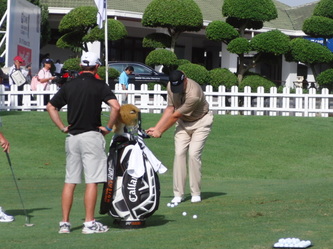


 RSS Feed
RSS Feed



